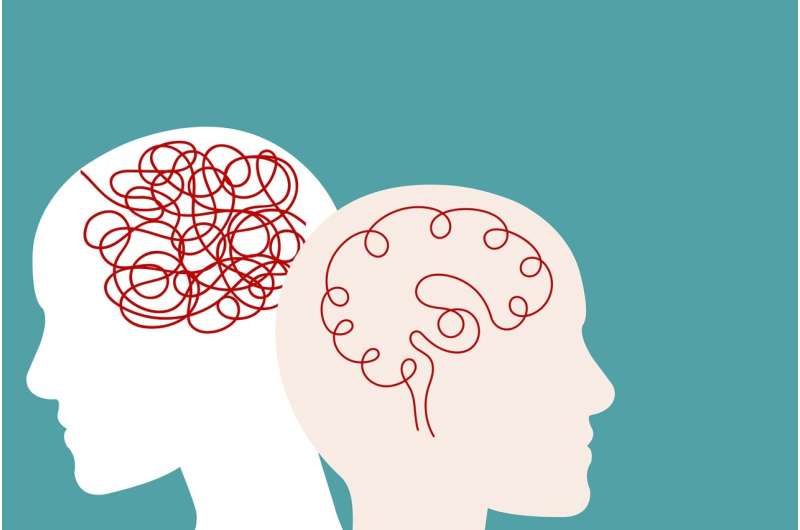
Credit: Pixabay/CC0 Public Domain
Mental disorders such as depression and anxiety are characterized by a variety of different symptoms, and individuals who receive the same diagnosis may experience different combinations of these symptoms. This way of defining mental disorders has been the subject of controversy, with some in the field concerned that symptom definitions are too broad.
A new Yale study finds that while there can be many possible combinations of symptoms that can lead to a certain diagnosis, most of those combinations are rarely, if ever, seen in the real world. The finding, the researchers say, means that broad criteria for mental disorders may not negatively affect diagnoses in practice, but combinations of symptoms may need to be considered when conducting research.
The study was published on August 7 in the journal JAMA Psychiatry.
The current approach to defining and diagnosing mental disorders originated in the third edition of the “Diagnostic and Statistical Manual of Mental Disorders (DSM),” published in 1980. The manual, now in its fifth edition, remains one of the classifications that is most often used. system for mental disorders.
“The core idea was to increase diagnostic reliability,” said Tobias Spiller, lead author of the study and a postdoctoral fellow in the laboratory of Ilan Harpaz-Rotem, professor of psychiatry at Yale School of Medicine. “So, for example, if two patients with the same symptoms went to different doctors, they would end up with the same diagnosis, which wasn’t always the case before.”
The result was a system where many symptoms were associated with a mental disorder and patients had to have certain symptoms or a certain number of potential symptoms to meet the criteria for a diagnosis.
“So while the approach has led to more reliable diagnoses, it also means that people with very different symptoms can qualify for the same diagnosis,” Spiller said.
Spiller and his colleagues suspected that there might be a pattern in symptom combinations that might be found in all mental disorders.
“One theory in mental health is that there is some kind of latent trait that causes the disorder,” said Or Duek, the study’s lead author and an assistant professor of psychiatry at the Yale School of Medicine.
In other words, disturbances are not random. Among the symptoms of a given disorder, some symptoms are more common than others, and certain symptoms are more likely to occur together than others. Therefore, the researchers said, some combinations of symptoms should be more common and some should be rare.
To test this, the researchers first built a simulation for an artificial mental disorder defined by five symptoms of which at least two of these symptoms had to be present to prompt a diagnosis. They then simulated 500 patients and calculated their symptom combinations, repeating this analysis 100 times.
They found that some combinations of symptoms – of which there were 32 possibilities – were very common, while most were rare.
This pattern was also true in real-world data. In the dataset for post-traumatic stress disorder (PTSD), major depression, schizophrenia, and generalized anxiety disorder, most symptom combinations occurred infrequently, and less than 10% of possible combinations were observed frequently.
For example, in the PTSD dataset, 99.8% of all possible symptom combinations were observed in less than 1% of subjects. Meanwhile, the most common 1% of combinations were reported by 46.2% of subjects.
“People have criticized the DSM for introducing so much heterogeneity, saying it doesn’t make sense to include so many symptoms,” Spiller said. “But here we show that although there are many different possibilities for combinations of traits, only a few are actually likely, and the heterogeneity doesn’t matter.”
But that could affect research, the researchers said.
“We need to be careful when trying to generalize the results of a particular study,” Duek said.
In clinics, doctors can often see the “textbook” cases – or patients with the most common symptom combinations. But specialized clinics can attract patients with atypical combinations.
If researchers conduct a study in one of the more specialized settings, their findings may not generalize to the broader population, Duek said. It could also contribute to the reproducibility problem in psychological research, where many research findings cannot be replicated in subsequent studies.
Although researchers should consider symptom variability when designing studies, the overall conclusion from this study is that this variability is not chaotic—it has structure and predictability.
“It seems abstract, but it’s really just a description of what doctors have been feeling,” Spiller said. “It’s a formal framework for understanding the assumptions and problems that doctors face on a daily basis.”
More information:
Tobias R. Spiller et al., Unveiling the Structure in Mental Disorder Presentations, JAMA Psychiatry (2024). DOI: 10.1001/jamapsychiatry.2024.2047
Provided by Yale University
Quotation: Symptoms of mental disorders appear in predictable ways, study finds (2024, August 8) Retrieved August 9, 2024 from https://medicalxpress.com/news/2024-08-mental-disorder-symptoms-ways.html
This document is subject to copyright. Except for fair dealing for the purpose of private research or study, no part may be reproduced without written permission. The material is provided for informational purposes only.
#Symptoms #mental #disorders #manifest #predictable #ways #study